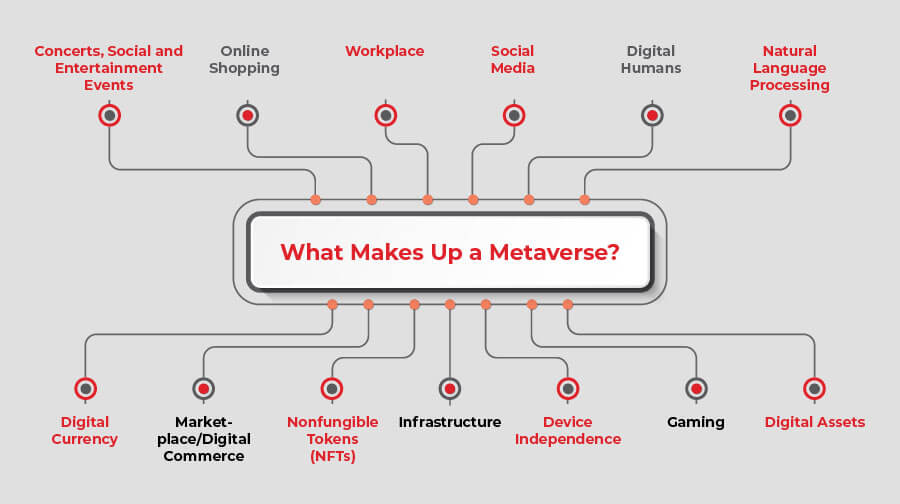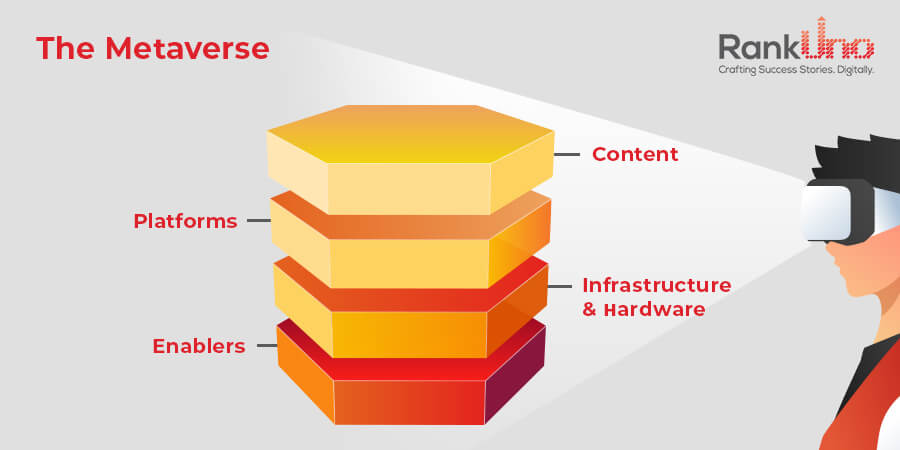We’ve all heard the story of how Alice went down a rabbit hole into an immersive world of fantastical ideas and propositions. Is metaverse the same wonderland reimagined? Is it a fad, or is it the future of how we communicate, do business, learn, and entertain ourselves?
For most, the metaverse seems like an enigma that straddles augmented reality (AR), virtual reality (VR), and the all-encompassing extended reality (XR). In its emerging state today, the metaverse is already attracting technology, talent, and investment from those who feel it is the future immersive internet.
Let’s look at the metaverse through a lens that tries to understand:
- How metaverse was born
- Metaverse today
- Metaverse tomorrow
- Value creation in the metaverse
- Potential of Metaverse
How it all started
The idea of the metaverse was in existence before Facebook decided to rebrand itself to Meta. This move was intended to cement the tech giant’s stride into the next-generation Web 3. However, the term metaverse was coined by author Neal Stephenson in 1992 in his novel Snow Crash. Moreover, the idea precedes the 90s and goes back to 1978 when MUD1 became the first-ever multiplayer real-time virtual world. Guess what? It was text-based!
The metaverse today is an emerging- or proto-metaverse. It can have a working definition as the next version of the internet that seamlessly combines our digital and physical lives. After rebranding to Meta, Mark Zuckerberg said, “We believe the metaverse will be the successor to the mobile internet. We’ll be able to feel present – like we’re right there with people no matter how far apart we actually are. Metaverse isn’t a thing a company builds. It’s the next chapter of the internet overall.”
This idea of being inside rather than outside is the real deal. Inherently, the metaverse isn’t good or bad; it will become what we make of it.
Metaverse today

In Apple CEO Tim Cook’s words, “I always think it’s important that people understand what something is. And I’m really not sure the average person can tell you what the metaverse is.”
The metaverse can be understood as a 3D virtual shared space created by converging virtually enhanced digital and physical reality. Moreover, it isn’t a single environment but a collective space that would encourage interoperability between various metaspheres.
While online gaming and its virtual worlds have been its most popular manifestations as yet, the metaverse encompasses various experiences such as immersive social media, virtual/physical online shopping, digital assets, and AR events. The Australian Open tennis tournament’s ‘Grand Slamming’ in the metaverse, hosted by Decentraland in June 2022, is an example of the metaverse’s evolution and the opportunities in virtual and augmented reality events.
Several organizations have reshaped their businesses to adapt to the evolving metaverse. While the online gaming industry still dominates the XR environment, the other big players are design software, social media, content creators, and AR/VR hardware industries. Tech giants are bullish on the evolution of the metaverse by pumping in more than USD 120 billion collectively in 2022 alone. Analysts have pegged the CAGR of the metaverse at 13.1%, and the metaverse market could be worth USD 800 billion by 2024. It is projected that at least one-fourth of the users would spend about an hour in the metaverse, and about one-third of businesses would offer services and products for the metaverse by 2026.
Structure of the metaverse

Still in its infancy, the structure of the metaverse consists of various layers that will shape how it grows and attains its eventual potential. To get a better grasp, let’s understand the prime elements involved in its evolution:
- Enablers: These include platforms engaged in managing the metaverse’s security, governance, identity, and monetization. The metaverse’s characteristic is its own digital currency and economy that will overlap the virtual and physical worlds. Most experts hope that the metaverse will not carry forward the tech giant-dominated internet of today and instead be a collaborative initiative that values privacy and security. This layer will be part of setting up and monitoring the governing rules.
- Infrastructure and hardware: The technological advances in the form of devices, interoperability bridges, operating software, and cloud infrastructure form this critical layer. As technological advancements improve, this metaverse layer will become more complex to include higher computing power for real-time experiences.
- Platforms: Platforms that drive access, discovery, and distribution of content are a part of this layer of the metaverse. It also includes the creators of 3D experiences and the development tools for designing, AI services, and game engines.
- Content: This is the public-facing layer of the metaverse consisting of metaspheres of content, applications, and virtual worlds. Content includes first-party content, developer, and user-generated content. Specific use cases of the metaverse from learning, training, collaboration, and other industry-specific applications will populate this layer. Moreover, it includes virtual worlds that cater to many users to gather, interact, create, and immerse in or leave various experiences.
Metaverse tomorrow
The metaverse of tomorrow must first deal with today’s challenges and convert them into opportunities that pave the way for its growth. These challenges lie in technological advancements, social adaptability, privacy, and security concerns.
In a canvassing study by Pew Research Center on the state of the metaverse in 2040, 46% of experts opined that various challenges would deter the metaverse from fully emerging the way its advocates foresee.
- If the metaverse mirrors the dominant internet platforms of today, the social implications of the metaverse may worsen. These include reduced autonomy, deepening digital divides, addiction to XR, and new forms of bullying and harassment. Challenges in privacy, monetizing personal data, deep fakes, misinformation, and further commercialization will spur better governance and compliance for helping the metaverse thrive.
- The lack of interoperability and uniformity between the present platforms hampers the growth and acceptability of the metaverse. A unifying code like the HTML of today can bridge devices and environments, creating seamless connections that can find wider adaptability.
- Computing and networking infrastructure today is limited, making it necessary to cap the number of users. The fiasco of the rock band Foo Fighters’ VR concert hosted by Meta is an example of how only 13000 attendees of the 61000 registered individuals could access a part of the event. High latency lagging, low bandwidth delays access to content. Computing powers are still evolving to render real-time augmented reality.
- The hardware used for XR experiences is clunky—AR/VR headsets are expensive and require significant advancements to become mainstream. Over the next decade, a broad set of peripherals like wearable sensors and haptics, contact lenses, and sleeker headsets might make the metaverse more accessible to a large population. Still, innovation looms far off on the horizon.
- As the metaverse is still in its infancy, the hype around an immersive digital universe has attracted investors by the hordes. However, since the shape and potential of the metaverse are still unclear, investors will also have to learn, test value-focused strategies, create user-compatible content, and prepare to scale by aligning operating models to suit the new environment.
Alice in wonderland
The metaverse is expected to be a wonderland where engagement and experiences will rule either in fully immersive virtual worlds or augmented and mixed reality spaces. The world is moving towards a pivotal point of the next big innovation wave in the form of Web 3 and metaverse. The challenges can be surmounted with technological advancements, governance, and security compliances. It is a whole new space for businesses to explore and experiment with services and products that the metaverse demands. The scope for creativity exists like never before. Content will continue to attract larger audiences; creativity will enhance experiences, and creators will bring value to businesses. This wonderland is just as scary as it is promising. Yet we must strive to get the Mad Hatters of the world to collaborate and steer clear of creating a Queen of Hearts.





